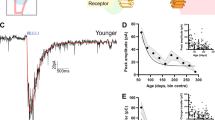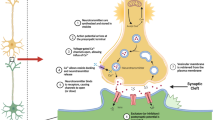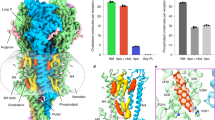Abstract
ACETYLCHOLINE, (CH3)3N+CH2CH2OCOCH3, the transmitter substance in cholinergic nervous systems, is a flexible molecule and the structure of active rigid analogues is therefore valuable for the determination of the conformation relevant to the various cholinergic systems. The muscarinic and nicotinic activities and the rate of hydrolysis by acetylcholinesterase of the isomers and enantiomers of 2-acetoxy cyclopropyl trimethylammonium iodide (ACTM) have been extensively studied by Long, Cannon, Armstrong and Chiu1,2. Their investigation was part of an attempt to determine the value of the transoid cisoid theory3 of the conformations of cholinergic molecules at muscarinic and nicotinic receptors respectively, using relatively rigid analogues of acetylcholine. The racemic compound (+,−)-cis-ACTM was shown to be relatively inactive in all cholinergic systems. The (+)-trans-enantiomer of ACTM was shown to be more potent than the (−)-trans-enantiomer in all cholinergic receptor systems and to be more rapidly hydrolysed by acetylcholinesterase as shown in Table 1. We have analysed the crystal structure of (+)-trans-ACTM by means of X-ray diffraction and determined the absolute configuration of the molecule by use of the effect of anomalous dispersion.
This is a preview of subscription content, access via your institution
Access options
Subscribe to this journal
Receive 51 print issues and online access
199,00 € per year
only 3,90 € per issue
Buy this article
- Purchase on SpringerLink
- Instant access to full article PDF
Prices may be subject to local taxes which are calculated during checkout
Similar content being viewed by others

References
Armstrong, P. D., Cannon, J. G., and Long, J. P., Nature, 220, 65 (1968).
Chiou, C. Y., Long, J. P., Cannon, J. G., and Armstrong, P. D., J. Pharmacol. Exp. Ther., 166, 243 (1969).
Schueler, F. W., J. Amer. Pharm. Ass. Sci. Ed., 45, 197 (1956).
Busing, W. R., Ellison, R. D., Levy, H. A., King, S. P., and Roseberry, R. T., The Oak Ridge Computer-controlled X-ray Diffractometer (USAEC publication ORNL 4143, 1968).
Jellineck, F., Acta Cryst., 10, 277 (1957).
Chothia, C. H., and Pauling, P. J., Chem. Commun., 626 (1969).
Pauling, P. J., and Petcher, T. R., Chem. Commun., 1248 (1969).
Chothia, C. H., and Pauling, P. J., Chem Commun., 746 (1969).
Gyermek, L., and Unna, K. R., Proc. Soc. Exp. Biol. Med., 98, 882 (1958).
Ellenbroek, B. W. J., and van Rossum, J. M., Arch. Intern. Pharmacodyn., 125, 216 (1960).
Beckett, A. H., Harper, N. J., Clitherow, J. W., and Lesser, E., Nature, 189, 671 (1961).
Belleau, B., and Puranen, J., J. Med. Chem., 6, 325 (1963).
Chothia, C. H., and Pauling, P. J., Nature, 219, 1156 (1968).
Chothia, C. H., Nature, 225, 36 (1970).
Chothia, C. H., and Pauling, P. J., Nature, 223, 919 (1969).
Author information
Authors and Affiliations
Rights and permissions
About this article
Cite this article
CHOTHIA, C., PAULING, P. Biological Sciences: Absolute Configuration of Cholinergic Molecules; the Crystal Structure of (+)-trans-2-Acetoxy Cyclopropyl Trimethylammonium Iodide. Nature 226, 541–542 (1970). https://doi.org/10.1038/226541a0
Received:
Issue Date:
DOI: https://doi.org/10.1038/226541a0
This article is cited by
-
Absolute crystal structure of (?)-N N-dimethylamphetamine methiodide
Journal of Crystal and Molecular Structure (1977)
-
Significance of the conformation during the interaction of biologically active molecules with receptors
Pharmaceutical Chemistry Journal (1976)
-
The Absolute Configuration and Crystal Structure of the Anticholinergic Drug Dexbenzetimide
Nature (1971)
-
Structure and Activity of Muscarinic Stimulants
Nature (1971)


